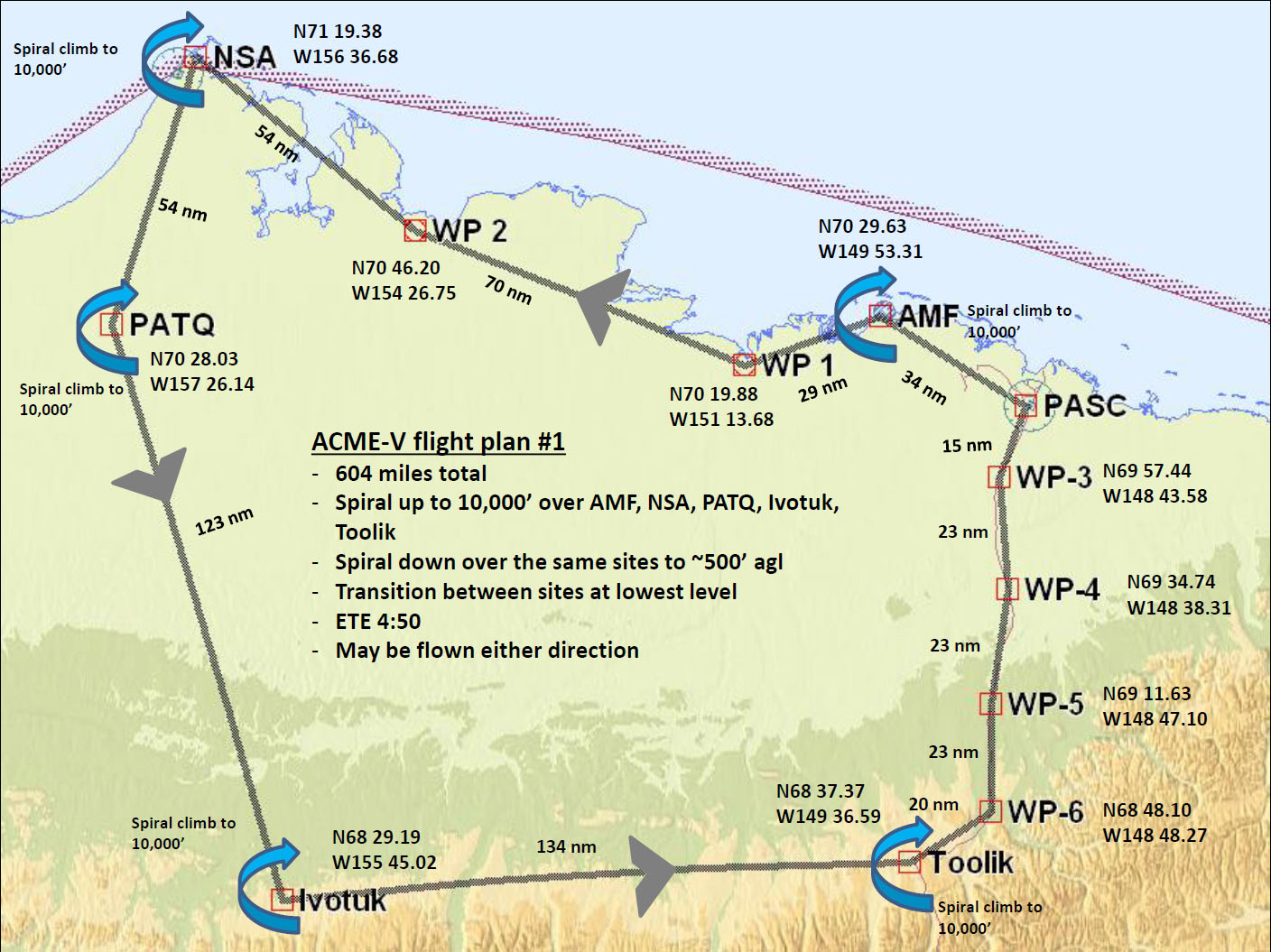ARMACMEV
ARM Airborne Carbon Measurements (ARM-ACME V)
1 June 2015 - 15 September 2015
Lead Scientist: Sebastien Biraud
Observatory: AAF (ARM Aerial Facility) - NSA (North Slope of Alaska) - OLI
Long-term airborne observations from the ARM Airborne Carbon Measurements (ARM-ACME) campaign and analysis of atmospheric trace gases in the Southern Great Plains contributed to research on regional carbon budgets, atmospheric dynamics, and satellite validation. Recently, the ARM-ACME project achieved the World Meteorological Organization precision goal of validated < 0.2 ppm precision for CO2, a first for airborne measurements. We continued our long-term airborne study of atmospheric composition and carbon cycling by conducting an exploratory campaign in the North Slope of Alaska (NSA). Atmospheric temperatures are warming faster in the Arctic than predicted by climate models. The impact of this warming on permafrost degradation is not well understood, but it is projected to increase carbon decomposition and greenhouse gas production (CO2 and/or CH4) by arctic ecosystems. Airborne observations of atmospheric trace gases, aerosols, and cloud properties at the North Slope of Alaska are improving our understanding of global climate, with the goal of reducing the uncertainty in global and regional climate simulations and projections. From June 1 through September 15, 2015, the ARM Aerial Facility deployed the Gulfstream-159 (G-1) research aircraft to fly over the North Slope of Alaska, with occasional vertical profiling to measure trace-gas concentrations between Prudhoe Bay, Oliktok Point, Barrow, Atqasuk, Ivotuk, and Toolik Lake. The aircraft payload included the Picarro and Los Gatos Research analyzers for continuous measurements of CO2, CH4, H2O, and CO, and N2O mixing ratios, and a 12-flask sampler for analysis of carbon-cycle gases (CO2, CO, CH4, N2O, 13CO2, 14CO2, carbonyl sulfide, and trace hydrocarbon species including ethane). The aircraft payload also included instruments for measuring aerosol properties (number size distribution, total number concentration, absorption, and scattering), cloud properties (droplet and ice size information), atmospheric thermodynamic state, and solar/infrared radiation. This research, supported by the U.S. Department of Energy’s (DOE) Atmospheric Radiation Measurement (ARM) Climate Research Facility and Terrestrial Ecosystem Science programs, built upon the results from the National Aeronautics and Space Administration (NASA) Carbon in Arctic Reservoirs Vulnerability Experiment missions (Miller et al. 2012), and the DOE Next-Generation Ecosystem Experiment Arctic project.Campaign Links
Related Publications
View all- Yang et al. "Hemispheric Asymmetry of Phase Partition in Mixed‐Phase Clouds Based on Near Global‐Scale Airborne Observations". 2025. 10.1029/2025GL115946.
Related Campaigns
Co-Investigators
Margaret Torn
Timeline
Campaign Data Sets
| IOP Participant | Data Source Name | Final Data |
|---|---|---|
| Sebastien Biraud | Continuous Carbon Dioxide | Order Data |
| Duli Chand | Particle Soot Absorption Photometer | Order Data |
| John Hubbe | Ambient Winds- AIMMS | Order Data |
| Alyssa Matthews | Cloud Droplet Probe | Order Data |
| Alyssa Matthews | High Volume Precip Spectrometer | Order Data |
| Alyssa Matthews | Water Content Monitor | Order Data |
| Fan Mei | 2D-S Particle Size | Order Data |
| Fan Mei | Condensation Particle Counter | Order Data |
| Fan Mei | Cloud Particle Imager (CPI) | Order Data |
| Fan Mei | Fast Cloud Droplet Probe (FCDP) | Order Data |
| Fan Mei | meteorology/state/position parameters | Order Data |
| Arthur Sedlacek | Single Particle Soot Photometer | Order Data |
| Stephen Springston | Carbon Monoxide - G1 Aircraft | Order Data |
| Jason Tomlinson | Passive Cavity Aerosol Spectrometer | Order Data |
| Jason Tomlinson | Ultra High Sensitivity Aerosol Spectrometer | Order Data |
Keep up with the Atmospheric Observer
Updates on ARM news, events, and opportunities delivered to your inbox



















